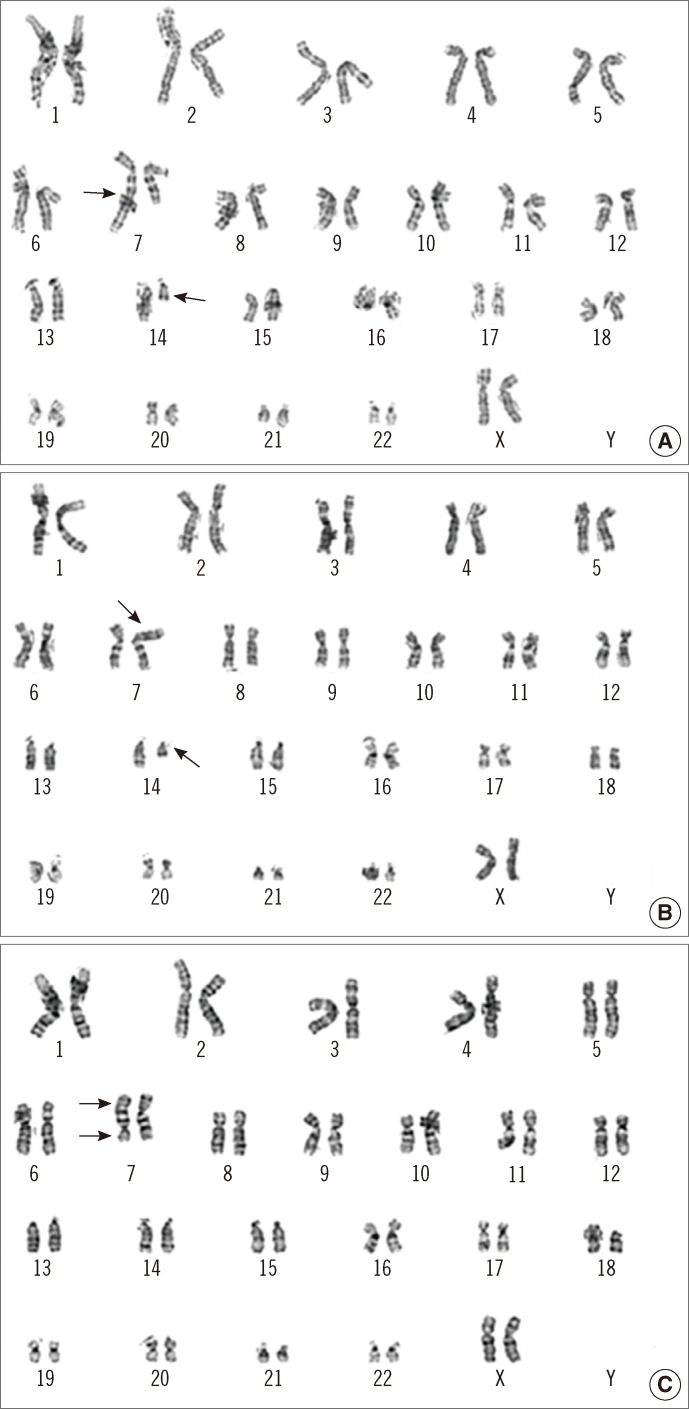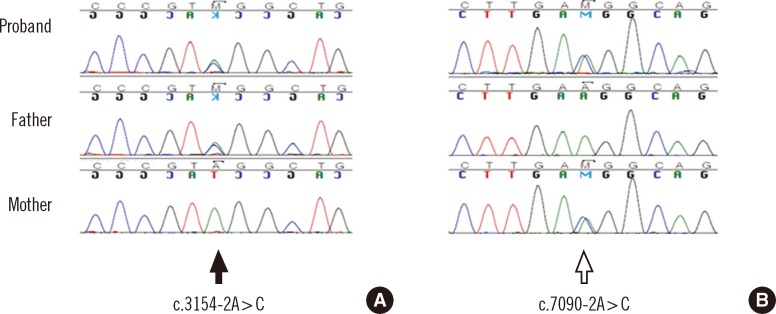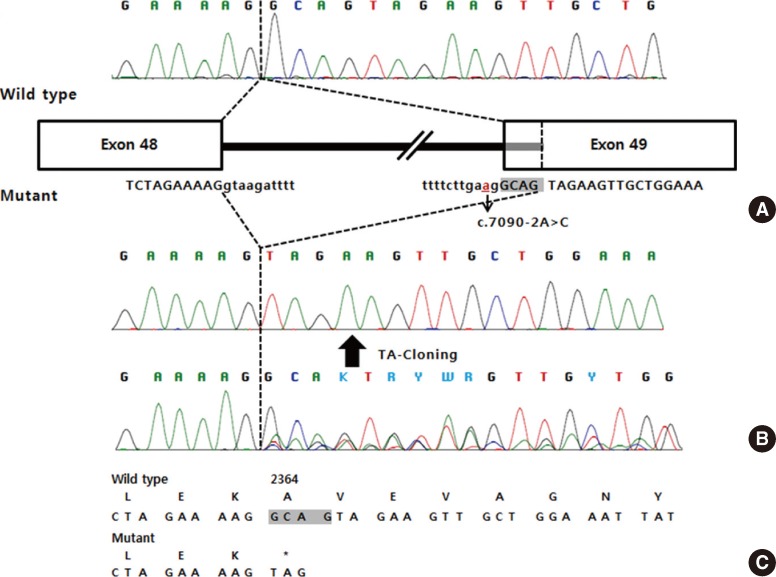Ann Lab Med.
2014 Jan;34(1):80-84. 10.3343/alm.2014.34.1.80.
Ataxia-Telangiectasia with Novel Splicing Mutations in the ATM Gene
- Affiliations
-
- 1Department of Neurology, Gyeongsang National University School of Medicine, Jinju, Korea.
- 2Department of Laboratory Medicine and Genetics, Samsung Medical Center, Sungkyunkwan University School of Medicine, Seoul, Korea. changski@skku.edu
- 3Department of Neurology, Samsung Medical Center, Sungkyunkwan University School of Medicine, Seoul, Korea.
- 4Department of Neurology, Soonchunhyang University Hospital, Soonchunhyang University School of Medicine, Seoul, Korea.
- KMID: 1781368
- DOI: http://doi.org/10.3343/alm.2014.34.1.80
Abstract
- No abstract available.
MeSH Terms
-
Adolescent
Ataxia Telangiectasia/*genetics
Ataxia Telangiectasia Mutated Proteins/*genetics
Base Sequence
Chromosome Inversion
Chromosomes, Human, Pair 14/genetics
Chromosomes, Human, Pair 7/genetics
DNA Mutational Analysis
Female
Humans
Karyotyping
Magnetic Resonance Imaging
Mutation
RNA Splicing
Translocation, Genetic
Ataxia Telangiectasia Mutated Proteins
Figure
Reference
-
1. Gatti R. Ataxia-Telangiectasia. In : Pagon RA, Bird TD, Dolan CR, Stephens K, editors. Gene Reviews. Seattle: University of Washington;1993.3. McKinnon PJ. ATM and the molecular pathogenesis of ataxia telangiectasia. Annu Rev Pathol. 2012; 7:303–321. PMID: 22035194.
Article4. Verhagen MM, Last JI, Hogervorst FB, Smeets DF, Roeleveld N, Verheijen F, et al. Presence of ATM protein and residual kinase activity correlates with the phenotype in ataxia-telangiectasia: a genotype-phenotype study. Hum Mutat. 2012; 33:561–571. PMID: 22213089.
Article5. Woods CG, Bundey SE, Taylor AM. Unusual features in the inheritance of ataxia telangiectasia. Hum Genet. 1990; 84:555–562. PMID: 2338342.
Article6. Jiang H, Tang B, Xia K, Hu Z, Shen L, Tang J, et al. Mutation analysis of the ATM gene in two Chinese patients with ataxia telangiectasia. J Neurol Sci. 2006; 241:1–6. PMID: 16380133.
Article7. Morio T, Takahashi N, Watanabe F, Honda F, Sato M, Takagi M, et al. Phenotypic variations between affected siblings with ataxia-telangiectasia: ataxia-telangiectasia in Japan. Int J Hematol. 2009; 90:455–462. PMID: 19705055.
Article8. Kang DW, Ahn SS, Jeon BS. A case of ataxia telangiectasia. J Korean Neurol Assoc. 1997; 15:895–899.9. Song MH, Kim EJ, Sung TJ, Shin SH, Lee KH, Kim HD. A case of progressive elevation of serum gamma-GTP level in ataxia-telangiectasia. J Korean Child Neurol Soc. 2006; 14:363–368.10. Huh HJ, Cho KH, Lee JE, Kwon MJ, Ki CS, Lee PH. Identification of ATM mutations in Korean siblings with ataxia-telangiectasia. Ann Lab Med. 2013; 33:217–220. PMID: 23667852.
Article11. Verhagen MM, Abdo WF, Willemsen MA, Hogervorst FB, Smeets DF, Hiel JA, et al. Clinical spectrum of ataxia-telangiectasia in adulthood. Neurology. 2009; 73:430–437. PMID: 19535770.
Article12. Gilad S, Chessa L, Khosravi R, Russell P, Galanty Y, Piane M, et al. Genotype-phenotype relationships in ataxia-telangiectasia and variants. Am J Hum Genet. 1998; 62:551–561. PMID: 9497252.
Article13. Stumm M, Neubauer S, Keindorff S, Wegner RD, Wieacker P, Sauer R. High frequency of spontaneous translocations revealed by FISH in cells from patients with the cancer-prone syndromes ataxia telangiectasia and Nijmegen breakage syndrome. Cytogenet Cell Genet. 2001; 92:186–191. PMID: 11435685.
Article14. Nowak-Wegrzyn A, Crawford TO, Winkelstein JA, Carson KA, Lederman HM. Immunodeficiency and infections in ataxia-telangiectasia. J Pediatr. 2004; 144:505–511. PMID: 15069401.
Article15. Laake K, Jansen L, Hahnemann JM, Brondum-Nielsen K, Lönnqvist T, Kääriäinen H, et al. Characterization of ATM mutations in 41 Nordic families with ataxia telangiectasia. Hum Mutat. 2000; 16:232–246. PMID: 10980530.
- Full Text Links
- Actions
-
Cited
- CITED
-
- Close
- Share
- Similar articles
-
- Identification of ATM Mutations in Korean Siblings with Ataxia-Telangiectasia
- Functional Link between DNA Damage Responses and Transcriptional Regulation by ATM in Response to a Histone Deacetylase Inhibitor TSA
- Ataxia-Telangiectasia Mutated Is Involved in Autolysosome Formation
- Novel compound heterozygous mutations of ATM in ataxia-telangiectasia: A case report and calculated prevalence in the Republic of Korea
- Survival, Differentiation and ATM Phenotype of PC-12 Cells by Down - regulation of AT Gene







